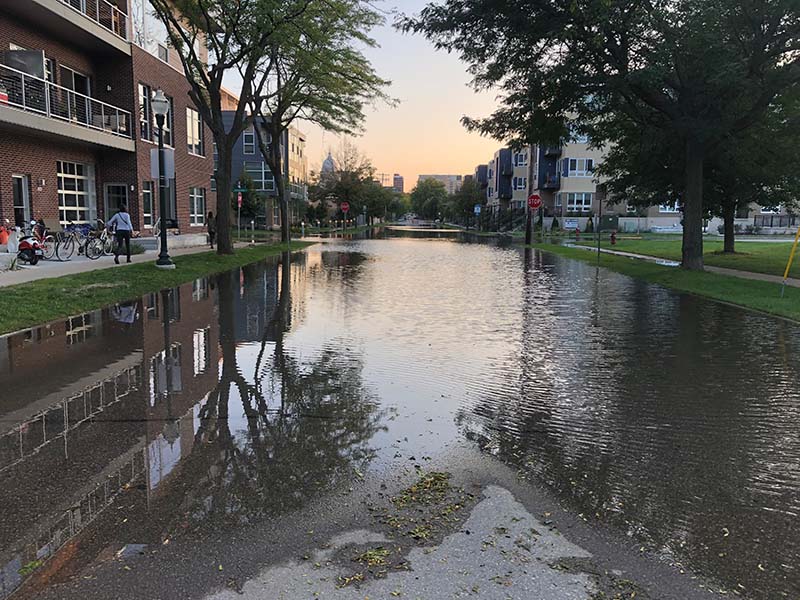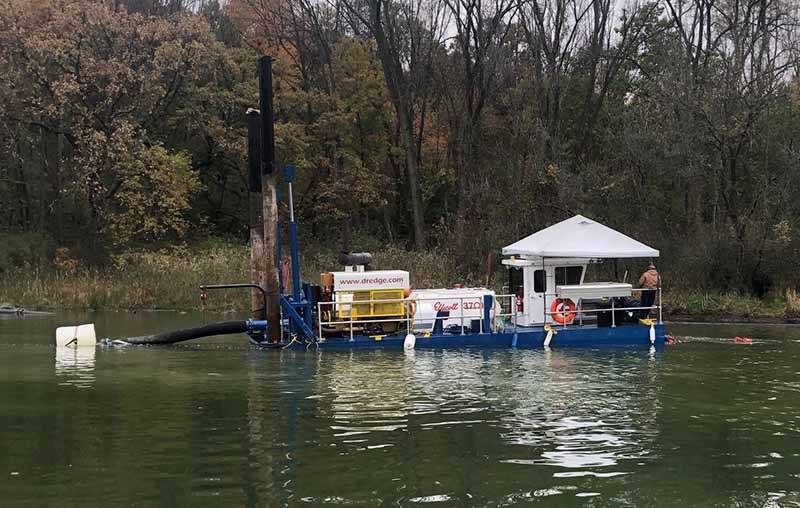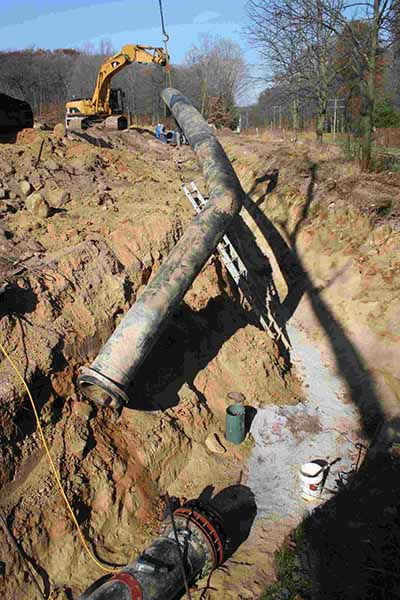Read this in Spanish / lee esto en español
Richard Lathrop is a retired research limnologist at the Wisconsin Department of Natural Resources and an honorary fellow at the University of Wisconsin-Madison Center for Limnology.
What is your role/who are you?
I was a career research limnologist for 33 years with the Department of Natural Resources; after retiring, I have continued to work on the Devil’s Lake rehabilitation project as a part-time scientist. I am also an honorary fellow at the University of Wisconsin-Madison, Center for Limnology where I have worked on the North Temperate Lakes Long-Term Ecological Research (LTER) project since 1995.
What has been happening with flooding in Southern Wisconsin?
We have to think about flooding in two ways. One is acute resulting from massive rainstorms causing giant peak flows that produce channel erosion and localized flooding. This occurred in August 2018 in Middleton when they had 11 inches of rain. The peak flow surge washed out the bridges, walkways, and banks throughout the Pheasant Branch stream corridor in the Pheasant Branch Conservancy. Homes and businesses were also flooded.

The other aspect of flooding is chronic. That type of flooding affects the areas around lakes when their water levels become high because we are having more rainfall and the lakes are not able to get rid of that excess water. In the case of a drainage lake system that has a natural outlet like each of the Madison lakes, water levels can build up so high that the outlets are not able to get rid of the water fast enough. When you have an extreme rainfall event on top of that high water level there is no place to send the water and you have flooding.
Flooding problems in closed basin lakes, otherwise called seepage lakes, are particularly a problem because these types of lakes have no natural surface water outlet to lower water levels. If annual precipitation is increasing as an overall trend, we get higher groundwater levels and we get more water falling on the lake. The lake levels get very high and we get flooding of infrastructure along the lakeshore.
In these closed basin systems, the lake mainly loses its excess water through evaporation. Normally you can lose some water through the groundwater system but with the water table so high because of the increased precipitation, you can’t get rid of the excess water and you have increased flooding problems.
There is chronic flooding in the Madison lakes that builds up the water levels in the lakes because of increased streamflow entering from the lakes’ large watershed. The result is higher lake levels because the downstream outlet channels of the lakes have filled in and they don’t have the capacity to get rid of the water fast enough. When Lake Monona water levels are high many of the wetland areas that were filled in for infrastructure have storm sewers that are under water. Then, when it rains, there’s no place to put the water.
We need to be able to drain the lakes faster so we don’t have a chronic flooding problem and have some storage in the lake for when we have a big rain event. We need to get to where we don’t start with the lake two feet over its normal summer range like what happened in 2018. There was so much water entering the lakes at the end of the winter period that water levels got high and then we had this massive rain event in August of 2018 that caused flooding.
Dane County has recognized the problem and started a multi-year dredging project and are deepening the river channels downstream of each of the four Yahara lakes in five phases. This will move more water faster out of the lakes between rainstorms so when a big rainstorm hits, the lakes will be at a lower level. This will give them more resilience to acute rainstorms.

What are some solutions for lakes without outlets, closed basin systems?
Devil’s Lake in Sauk County, and nearby Fish Lake and Crystal Lake in northwest Dane County are closed basin systems with no outlets. Fish Lake at the end of 2020 had risen 17 feet since the early 1970s. Crystal Lake has also risen to a level that caused it to overtop with water flowing into Fish Lake in 2019-2020. With the increased precipitation and one event occurring after another, it makes the lake levels keep going up. Fish Lake residents tried to lower their lake level using a pump to get the water to the Wisconsin River, but it did not work well.
The electricity costs are tremendous to pump water at the capacity you need to lower lakes levels. A small lake district can’t afford to run and maintain the pump. Crystal Lake had the same problem with pumping. The situation in Fish Lake and Crystal Lake is that they now likely will have a new, higher, normal lake level.
In Devil’s Lake, the centerpiece to Wisconsin’s most popular state park, in 2002 we put in a bottom withdrawal pipe system to get phosphorus out of the lake to improve water quality. In 2008 following a winter of record snowfall and high spring rains, a series of early June storms raised the lake level to a point that the lake overtopped causing massive destruction. Because the siphon as originally designed could not be “primed” (filled with water) until the park’s water system was turned on in mid-April, the lake level had already exceeded flood stage by more than two feet.
As a result of that catastrophic flooding event, in November 2009 we modified the siphon pipe to make it a gravity feed system for filling (and degassing) that has allowed the siphon pipe to run anytime. This has proactively kept the lake from exceeding the ordinary high water mark even during the 2018 and 2019 major flooding events that created such problems in the Madison lakes, Fish Lake, and Crystal Lake. To make this type of siphon pipe system work, you need the right topography, a short distance to a major waterway, and land rights to lay the pipe. Devil’s Lake was the perfect place to implement a siphon outlet — an important adaptation strategy. We were able to get rid of excess water to prevent chronic flooding.
What should local officials know?
Climate change projections are for more rainfall in fall, winter, and spring in southern Wisconsin. That means there will be impacts from chronic flooding. Communities located around water bodies need to be able to maintain their lakes at a normal water level range so they can handle extreme rain events. In drainage lakes, the chronic problem has solutions by getting water away faster through the lake outlets.

In closed basin lakes, installed outlet pipes discharging water passively via siphon systems or expensive pumps may be needed. If such systems can’t be used, people will have to adapt to the new normal higher water levels. At Crystal Lake, they have relocated their homes to higher ground; in Fish Lake the destroyed shoreline homes were purchased by Dane County and will soon be removed.
Communities will also have to deal with extreme rainfall events to protect their infrastructure. They need to hold the water back on the land, infiltrate it, retain the water, and reduce the peak flows with detention basins to help lessen the erosive power of peak flows during the extreme event.
Do you have hope for the future?
I think people are recognizing that climate change is happening. There are some solutions but we are going to have to spend the money and resources and make the decisions necessary to become more resilient. We need to reduce greenhouse gases globally to keep things from getting even worse in the future, but we are already living with these challenges at the local level where we need to adapt.
Learn More
The views and opinions expressed in this interview are those of the authors and do not represent official policy or position of the University of Wisconsin-Madison or the Wisconsin Initiative on Climate Change Impacts.
For More Information
Richard C. Lathrop, PhD
Research Limnologist (retired)
Wisconsin Department of Natural Resources
Honorary Fellow
University of Wisconsin-Madison Center for Limnology
rlathrop@wisc.edu